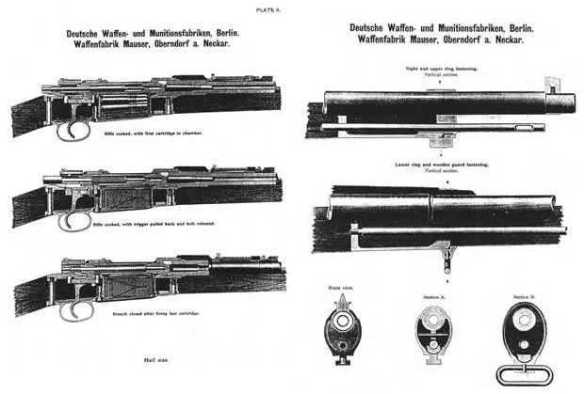The Mauser Rifle, 1895. Enhanced illustration from an original series of catalogues, 1898.
Peter Paul Mauser must stand by the side of Mikhail Timofeyevich Kalashnikov in the annals of rifle designers. Just as Kalashnikov and his famous rifle are known to everyone today, so, too, was Mauser in the period 1900-1945. He was born in Oberndorf, Germany, in 1838, the son of a gunsmith who worked in the Wurtemberg State Arsenal.
The younger Mauser served his apprenticeship in the same factory, and by 1866 he had produced an experimental self-cocking Dreyse needle gun. By 1867, however, he had moved to Liege, Belgium, where a modified Chassepot rifle was produced. At the time, Mauser was associated with an American, Samuel Norris of Springfield, Massachusetts, but this partnership was dissolved when Remington and Sons, Norris’s employers, found out what he was up to. By 1870 his C/70 rifle design was seen to be vastly superior to the Dreyse design and to the Beck modified versions of the needle rifle. (Johannes Beck redesigned the bolt head to improve the original needle rifle mechanism.) This resulted in the production of an initial 2,500 versions for field trials, and the Infanterie-Gewehr (Infantry Rifle) Model 1871 was officially adopted by the Prussian Army on 22 March 1872. This rifle underwent modification, and the revolution in magazine design was soon incorporated, the designation becoming the Infanterie-Gewehr M1871/84.
The arrival of new cordite technology stopped Mauser for a while, but he soon fought back with designs that were sold abroad, although some of his designs were not bought by the German government. By combining the need for more chamber strength (to cope with cordite) and by incorporating a five-round box magazine, Mauser brought his rifle up to world standards, and via various modifications he finally brought out the Gewehr 98, a rifle that rivals the Lee-Enfield in the affections of gun collectors and crack shots all over the world. The rifle also confronted the Lee-Enfield in the serious business of war on two major occasions, with Britain and German fielding their own versions of the rifles against one another from 1914 to 1918, and again from 1939 to 1945.
The rifle was a bolt-action box magazine weapon. Acting on various reports received about previous weapons he had designed, Mauser set out to make the perfect infantry rifle, and in many minds he succeeded. The design itself concentrated on safety and ease of use in the field. The weapon was strong and had more than adequate safety features to ensure that the user was not injured by the firing pin penetrating through the primer into the cartridge body; the receiver was strengthened as well, against the event of an overloaded cartridge being fired.
The action of the bolt is considered rather sloppy, but this is because Mauser allowed generous tolerances for his working parts, which made sure that the rifle was able to function in the most adverse conditions of mud or ice. The standard version was 4 feet, 1 inch long and weighed 9 pounds, 4 ounces. The magazine held five charger-loaded cartridges. The barrel was 29.1 inches long, with four clockwise rifling grooves with a pitch of one turn in 9.39 inches.
The weapon was chambered for the 7.92mm Mauser cartridge. This cartridge originally held 40.75 grains of nitrocellulose powder behind a 227-grain cupro-nickel-coated, steel-jacketed bullet. Muzzle velocity was a remarkable 2,093 fps. Acceptance of the rifle by the German Army was instantaneous. Interestingly, after World War I, Mauser sued the U. S. government successfully for infringement of his patents, because the U. S. Army adopted the Springfield M1903 rifle, a Mauser in all but.
Mauser designed an SLR (Flieger-Ballon-und Zeppelin Truppe Model 16), of which 1,000 were made. They had to be kept scrupulously clean, but demand far exceeded supply. Further manufacture was a problem not addressed by Mauser, and the weapons that survive are extremely rare. The idea had caught on, however, and the Germans never stopped experimenting with SLRs. The first of Mauser’s postwar SLRs was the G35, designed as a result of the success of the Czech ZH-29 SLR (designed by Vladimir Holek; hundreds were sold, including at least 500 to Manchuria). The G35 was a short-barrel recoil weapon and was out of favor compared with the gas-operated systems appearing elsewhere, which were more conventional in barrel length.
The ammunition question refused to die, however, and the lead in ammunition technology the Germans established during World War II brought the matter to the fore after the end of that war. The Germans began the war with the Mauser Gew 98k in 7.92mm caliber. This was a shortened version of Mauser’s famous Gew 98. However, experiences in Russia during OPERATION BARBAROSSA convinced the Germans that they needed an SLR to combat the masses of Russian soldiers counterattacking them and that they also needed a controllable assault rifle capable of automatic or, at least, rapid semiautomatic fire.
An early attempt to provide such a weapon resulted in failure. The Mauser G41(M) was judged too heavy (it weighed over 11 pounds), it was muzzle-heavy and too long, and the action was awkward. The weapon was scrapped in favor of the Walther G41, which soon became the target of Waffen SS demands to supply “the SS units standing on the front [with] an automatic carbine.”
